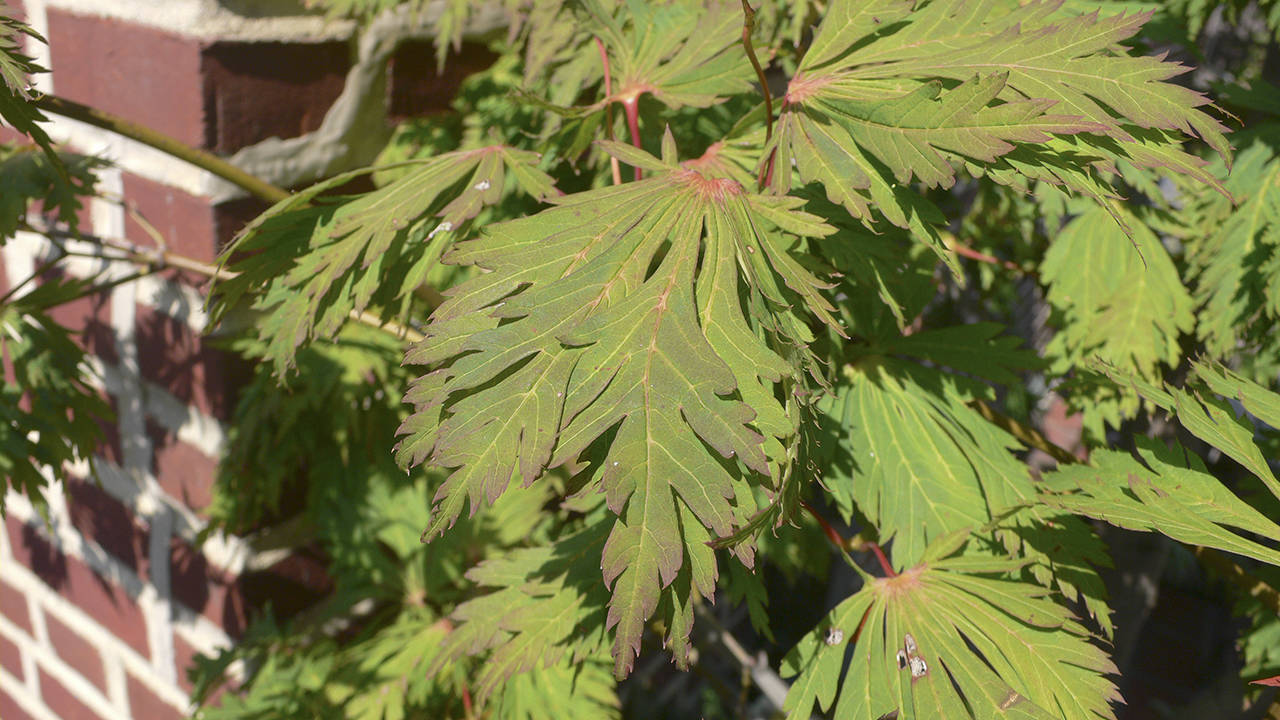By Dolores Cavanah
WSU Master Gardener
Last month, I talked about the iris, which represents “I” on my alphabetical list of favorite plants. Continuing today is “J.”
The Japanese maple is my all-time favorite deciduous tree.
Acer palmatum is the best-known maple native to Japan — 20 to 25 feet tall and upright, with a small green leaf and attractive leaf colors. Among the over 1,500 various cultivars of Acer palmatum, there are about 350 distinctly different Japanese maples, which allows for the various colors. Some have green leaves, some red, others multicolored. Some glow in the spring, and others display their colors in the fall.
The tree’s dramatic effect comes from leaf shape, bark colors and textures, or constantly changing colors for each season. The leaves vary widely, ranging from 2 to 4 inches, and from simple ovals to deeply lobed and finely dissected shapes. Common to all maples is the fruit, called samara, that float along in a breeze like wing nuts.
Some varieties are as short as one foot, others as tall as 25 feet or more, with shapes from round to columnar, from conical to weeping, and many other forms in between.
Most maples will grow in soils ranging from sandy loam to clay. They are mostly hardy from Zones 5 to 8 and grow exceptionally well in our Pacific Northwest climate because of our rather acidic soil.
Japanese maples enhance the garden as a spectacular centerpiece, focal point or accent, as well as working as a group to provide a dramatic backdrop as a beautiful, colorful collage.
Planting Japanese maples in containers is an excellent way to display them singularly or in a collection on a patio, terrace or deck, or in the garden landscape.
The Japanese maple is easy to maintain. It can be pruned for any shape you desire at any time of the year except when leafing out. Light treatment with a balanced fertilizer early in the year and then a second one around Easter is enough for the full year.
Most Japanese maples grow at a slow to moderate rate of one to two feet per year, growing faster when they are young and slowing down as they reach maturity. For best color, most maples need a location with part day’s sun — although here in the Pacific Northwest, they will grow and have good color in full sun as well as part shade.
Pests are not a problem, although one or two times an elk has taken a bite and then spit it out in my garden.
Some of the Japanese maples in my garden in the Acer palmatum group are A. Sango Kaku, also known as coral bark maple, an upright tree. In winter, twigs and branches are a striking coral color with light green leaves and yellow fall foliage.
Acer palmatum var. dissectum (laceleaf Japanese maple) has drooping branches. There are many other variations on the palmatum theme with the drooping branches and a variety of reds and purples.
Among the upright palmatum varieties is the vigorous bloodgood maple, with red spring and summer foliage and scarlet in fall.
Another upright is A. japonicum acontifolium (full moon maple), with leaves that open pale gold in spring and remain a pale chartreuse.
A. griseum (paperbark maple) has bare branches, and the main trunk in winter has reddish bark peeling in very thin paper sheets. The dark green leaves turn brilliant red in fall.
A good time to purchase Japanese maples from a nursery is in the fall, when one can see the variety of colors in person.
■ ■ ■
On July 20, enjoy the WSU Master Gardeners’ annual garden tour, which is in Ocean Shores this year. Tickets are $12 and may be purchased at the usual ticket outlets in Grays Harbor and Pacific counties.
This article, by Master Gardener Dolores Cavanah, is part of an occasional series in which she describes the plants she most admires at her expansive garden at Schafer Meadows, east of Montesano.


